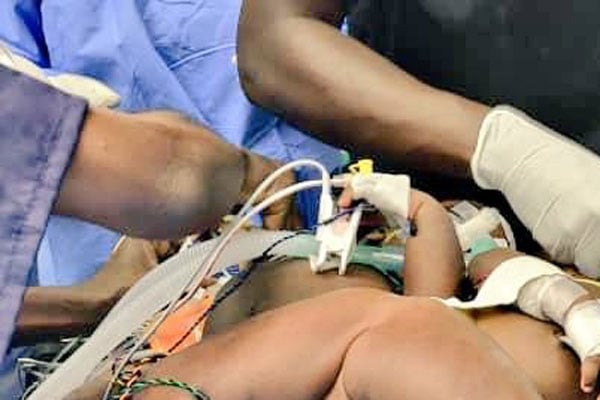Mulago separates Siamese twins

A team of Ugandan specialists at Mulago National Referral Hospital conduct an operation to separate Siamese twins yesterday. Photo/Ministry of Health
What you need to know:
- Dr John Sekabira said annually, Mulago hospital receives three to four siamese twins though unfortunately by the time of referral, they end up with infections and do not survive to live up to surgery as the midwives do not do due diligence during delivery.
- Dr Baterana Byarugaba, the Mulago hospital executive director, said these kind of services will reduce referrals abroad. Health workers advise pregnant women to attend antenatal care to be able to identify complications and abnormalities at an early stage.
A team of about 20 Ugandan specialists at Mulago National Referral Hospital have successfully separated Siamese twins.
Dr John Sekabira, a senior consultant paediatric surgeon at Mulago hospital, said it was established that the twins shared sacrum bone, which forms the lower back of the body, urethra, spinal cord that was conjoined at the end as well as the rectum, among others.
“Yesterday (Monday) 8am, the babies were already in theatre and the anesthetic team started preparing them, put them to sleep which is not easy, they have to go through vigorous rehearsals, putting central lines, monitor movement of muscles, every muscle of the body, you see the movement so that before you divide the nerve you know which nerve serves which muscle, it took about three hours,” Dr Sekabira said yesterday.
“At about 12pm, proper surgery started, it is not simple surgery, you have to move slowly because if you injure any nerve, they might not be able to walk, we were working in teams, by the time we separated the twins, it was 4am. Another team of neurosurgeons have to start covering the tubes so that the nerves can be protected and the plastic surgeons close the defect. It was 8am by the time we finished that,” he added.
According to MedicalNet, Siamese twins are identical but did not separate fully from one another.
Due to the incomplete division of one fertilised ovum, such twins are known medically as conjoined twins.
“We hope that after six months to a year, the tissues will have healed to go through the inflammatory phase and then we shall be able to put the vagina and rectum where they are supposed to be, and probably create the urethra,” Dr Sekabira said.
Breakthrough
He said they decided to separate the twins from here because they realised the surgery is not complicated, adding that they have the expertise to do that kind of surgery.
Seven years ago, conjoined twins were taken to Egypt for surgery due to lack of equipment in the country.
The twins were born at the end of December last year in Lira Regional Referral Hospital and were later transferred to Mulago hospital.
Dr Rosemary Byanyima, the deputy director of Mulago hospital, said the separation could not be done then due to their delicate nature at the time.
The operation was done at no cost as the hospital is currently doing a test run.
However, it is stated that in India, this surgery would cost at least $100,000 (Shs370m).





